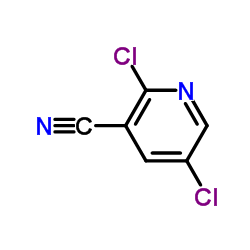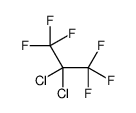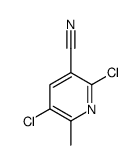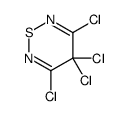13063-43-9
| 中文名 | 二氯丙二腈 |
|---|---|
| 英文名 | Dichloromalononitrile |
| 英文别名 |
EINECS 235-955-4
MFCD00001841 2,2-dichloropropanedinitrile DICHLOROMALONONITRILE |
| 密度 | 1.312 g/mL at 25 °C(lit.) |
|---|---|
| 沸点 | 97 °C(lit.) |
| 分子式 | C3Cl2N2 |
| 分子量 | 134.95200 |
| 闪点 | >230 °F |
| 精确质量 | 133.94400 |
| PSA | 47.58000 |
| LogP | 1.20746 |
| 蒸汽压 | 42.5mmHg at 25°C |
| 折射率 | n20/D 1.431(lit.) |
| 储存条件 | 常温密闭,阴凉通风干燥 |
| 稳定性 | 常温常压下稳定 避免的物料 氧化物 |
| 分子结构 | 1、 摩尔折射率:25.43 2、 摩尔体积(m3/mol):87.6 3、 等张比容(90.2K):240.0 4、 表面张力(dyne/cm):56.3 5、 极化率(10-24cm3):10.08 |
| 计算化学 | 1.疏水参数计算参考值(XlogP):1.1 2.氢键供体数量:0 3.氢键受体数量:2 4.可旋转化学键数量:0 5.互变异构体数量:无 6.拓扑分子极性表面积47.6 7.重原子数量:7 8.表面电荷:0 9.复杂度:136 10.同位素原子数量:0 11.确定原子立构中心数量:0 12.不确定原子立构中心数量:0 13.确定化学键立构中心数量:0 14.不确定化学键立构中心数量:0 15.共价键单元数量:1 |
| 更多 | 1. 性状:无色液体 2. 密度(g/mL, 25 ℃ ):1.310 3. 相对蒸汽密度(g/mL,空气=1):未确定 4. 熔点(ºC):未确定 5. 沸点(ºC,常压):96-94 6. 沸点(ºC,0.1mmHg):未确定 7. 折射率:1.4335 8. 闪点(ºC):>110 9. 比旋光度(º):未确定 10. 自燃点或引燃温度(ºC):未确定 11. 蒸气压(20ºC):未确定 12. 饱和蒸气压(kPa,60ºC):未确定 13. 燃烧热(KJ/mol):未确定 14. 临界温度(ºC):未确定 15. 临界压力(KPa):未确定 16. 油水(辛醇/水)分配系数的对数值:未确定 17. 爆炸上限(%,V/V):未确定 18. 爆炸下限(%,V/V):未确定 19. 溶解性:未确定 |
Synonym:Malononitrile, dichloro Section 2 - COMPOSITION, INFORMATION ON INGREDIENTS
Risk Phrases: 23/24/25 Section 3 - HAZARDS IDENTIFICATION EMERGENCY OVERVIEW
Toxic by inhalation, in contact with skin and if swallowed.Lachrymator (substance which increases the flow of tears).Toxic. Potential Health Effects Eye: Causes severe eye irritation. Lachrymator (substance which increases the flow of tears). May cause chemical conjunctivitis and corneal damage. Skin: Causes severe skin irritation. Ingestion: Harmful if swallowed. May cause gastrointestinal irritation with nausea, vomiting and diarrhea. Inhalation: May cause respiratory tract irritation. May cause burning sensation, coughing, wheezing, laryngitis, shortness of breath, headache, nausea, and vomiting. Chronic: Effects may be delayed. Section 4 - FIRST AID MEASURES Eyes: Immediately flush eyes with plenty of water for at least 15 minutes, occasionally lifting the upper and lower eyelids. Get medical aid immediately. Do NOT allow victim to rub eyes or keep eyes closed. Skin: Get medical aid. Flush skin with plenty of water for at least 15 minutes while removing contaminated clothing and shoes. Ingestion: Never give anything by mouth to an unconscious person. Get medical aid immediately. Do NOT induce vomiting. If conscious and alert, rinse mouth and drink 2-4 cupfuls of milk or water. Inhalation: Get medical aid immediately. Remove from exposure and move to fresh air immediately. If breathing is difficult, give oxygen. Do not use mouth-to-mouth resuscitation if victim ingested or inhaled the substance; induce artificial respiration with the aid of a pocket mask equipped with a one-way valve or other proper respiratory medical device. Notes to Physician: Section 5 - FIRE FIGHTING MEASURES General Information: As in any fire, wear a self-contained breathing apparatus in pressure-demand, MSHA/NIOSH (approved or equivalent), and full protective gear. During a fire, irritating and highly toxic gases may be generated by thermal decomposition or combustion. Vapors may be heavier than air. They can spread along the ground and collect in low or confined areas. Extinguishing Media: In case of fire, use water, dry chemical, chemical foam, or alcohol-resistant foam. Section 6 - ACCIDENTAL RELEASE MEASURES General Information: Use proper personal protective equipment as indicated in Section 8. Spills/Leaks: Absorb spill with inert material (e.g. vermiculite, sand or earth), then place in suitable container. Section 7 - HANDLING and STORAGE Handling: Wash thoroughly after handling. Remove contaminated clothing and wash before reuse. Use with adequate ventilation. Do not get in eyes, on skin, or on clothing. Do not ingest or inhale. Use only in a chemical fume hood. Do not breathe vapor. Storage: Store in a cool, dry, well-ventilated area away from incompatible substances. Keep containers tightly closed. Section 8 - EXPOSURE CONTROLS, PERSONAL PROTECTION Engineering Controls: Facilities storing or utilizing this material should be equipped with an eyewash facility and a safety shower. Use adequate ventilation to keep airborne concentrations low. Exposure Limits CAS# 13063-43-9: Personal Protective Equipment Eyes: Wear appropriate protective eyeglasses or chemical safety goggles as described by OSHA's eye and face protection regulations in 29 CFR 1910.133 or European Standard EN166. Skin: Wear appropriate protective gloves and clothing to prevent skin exposure. Clothing: Wear appropriate protective clothing to prevent skin exposure. Respirators: Wear a NIOSH/MSHA or European Standard EN 149 approved full-facepiece airline respirator in the positive pressure mode with emergency escape provisions. Section 9 - PHYSICAL AND CHEMICAL PROPERTIES Physical State: Clear liquid Color: clear yellow Odor: None reported. pH: Not available. Vapor Pressure: Not available. Viscosity: Not available. Boiling Point: 97 deg C @ 760.00mmHg Freezing/Melting Point: Not available. Autoignition Temperature: Not applicable. Flash Point: > 112 deg C (> 233.60 deg F) Explosion Limits, lower: Not available. Explosion Limits, upper: Not available. Decomposition Temperature: Not available. Solubility in water: Not available. Specific Gravity/Density: 1.3120g/cm3 Molecular Formula: C3Cl2N2 Molecular Weight: 134.95 Section 10 - STABILITY AND REACTIVITY Chemical Stability: Stable under normal temperatures and pressures. Conditions to Avoid: Incompatible materials, excess heat. Incompatibilities with Other Materials: Strong acids, strong bases, strong oxidizing agents, strong reducing agents. Hazardous Decomposition Products: Hydrogen chloride, nitrogen oxides, carbon monoxide, carbon dioxide, chloride fumes. Hazardous Polymerization: Has not been reported. Section 11 - TOXICOLOGICAL INFORMATION RTECS#: CAS# 13063-43-9: OO3740000 LD50/LC50: CAS# 13063-43-9: Draize test, rabbit, skin: 200 uL/24H Severe; Oral, rabbit: LD50 = >126 mg/kg; Oral, rat: LD50 = 130 mg/kg. LD50: Oral, rat = 130 Carcinogenicity: Dichloromalononitrile - Not listed by ACGIH, IARC, or NTP. Other: See actual entry in RTECS for complete information. Section 12 - ECOLOGICAL INFORMATION Section 13 - DISPOSAL CONSIDERATIONS Dispose of in a manner consistent with federal, state, and local regulations. Section 14 - TRANSPORT INFORMATION IATA Shipping Name: TOXIC LIQUID, ORGANIC, N.O.S.* Hazard Class: 6.1 UN Number: 2810 Packing Group: II IMO Shipping Name: TOXIC LIQUID, ORGANIC, N.O.S. Hazard Class: 6.1 UN Number: 2810 Packing Group: II RID/ADR Shipping Name: TOXIC LIQUID, ORGANIC, N.O.S. Hazard Class: 6.1 UN Number: 2810 Packing group: II Section 15 - REGULATORY INFORMATION European/International Regulations European Labeling in Accordance with EC Directives Hazard Symbols: T Risk Phrases: R 23/24/25 Toxic by inhalation, in contact with skin and if swallowed. Safety Phrases: S 24/25 Avoid contact with skin and eyes. WGK (Water Danger/Protection) CAS# 13063-43-9: No information available. Canada None of the chemicals in this product are listed on the DSL/NDSL list. CAS# 13063-43-9 is not listed on Canada's Ingredient Disclosure List. US FEDERAL TSCA CAS# 13063-43-9 is not listed on the TSCA inventory. It is for research and development use only. SECTION 16 - ADDITIONAL INFORMATION N/A |
|
毒理学数据: 1. 急性毒性:大鼠口服LD50:130mg/kg;小鼠腹腔LD50:10mg/kg;兔子口服LD50:>126mg/kg 2. 皮肤眼睛刺激数据:兔子皮肤标准刺激测试:200 uL/24HREACTION SEVERITY : Severe 主要的刺激性影响: 在皮肤上面:刺激皮肤和粘膜 在眼睛上面:刺激的影响,强烈刺激性,伤害眼睛,催泪效果 致敏作用:没有已知的敏化现象 生态学数据: 通常对水体是稍微有害的,不要将未稀释或大量产品接触地下水,水道或污水系统,未经政府许可勿将材料排入周围环境。 CHEMICAL IDENTIFICATION
HEALTH HAZARD DATAACUTE TOXICITY DATA
|
| 危害码 (欧洲) | T:Toxic; |
|---|---|
| 风险声明 (欧洲) | R23/24/25 |
| 安全声明 (欧洲) | S26-S27-S37/39 |
| 危险品运输编码 | UN 2810 6.1/PG 2 |
| WGK德国 | 3 |
| RTECS号 | OO3740000 |
| 包装等级 | III |
| 危险类别 | 6.1 |
| 海关编码 | 2926909090 |
|
~% 
13063-43-9 |
| 文献:US2359266 , ; |
|
~% 
13063-43-9 |
| 文献:Justus Liebigs Annalen der Chemie, , p. 648 - 655 |
|
~% 
13063-43-9 |
| 文献:Chemische Berichte, , vol. 55, p. 1260 Chemische Berichte, , vol. 58, p. 1703 |
| 上游产品 3 | |
|---|---|
| 下游产品 7 | |
| 海关编码 | 2926909090 |
|---|---|
| 中文概述 | 2926909090 其他腈基化合物. 增值税率:17.0% 退税率:9.0% 监管条件:无 最惠国关税:6.5% 普通关税:30.0% |
| 申报要素 | 品名, 成分含量, 用途 |
| Summary | HS:2926909090 other nitrile-function compounds VAT:17.0% Tax rebate rate:9.0% Supervision conditions:none MFN tariff:6.5% General tariff:30.0% |











